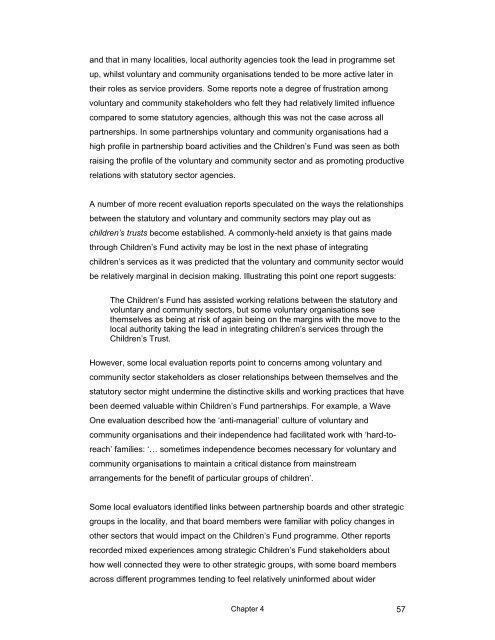Local Evaluation of Children's Services Learning from the Children's ...
Local Evaluation of Children's Services Learning from the Children's ...
Local Evaluation of Children's Services Learning from the Children's ...
- No tags were found...
You also want an ePaper? Increase the reach of your titles
YUMPU automatically turns print PDFs into web optimized ePapers that Google loves.
and that in many localities, local authority agencies took <strong>the</strong> lead in programme setup, whilst voluntary and community organisations tended to be more active later in<strong>the</strong>ir roles as service providers. Some reports note a degree <strong>of</strong> frustration amongvoluntary and community stakeholders who felt <strong>the</strong>y had relatively limited influencecompared to some statutory agencies, although this was not <strong>the</strong> case across allpartnerships. In some partnerships voluntary and community organisations had ahigh pr<strong>of</strong>ile in partnership board activities and <strong>the</strong> Children’s Fund was seen as bothraising <strong>the</strong> pr<strong>of</strong>ile <strong>of</strong> <strong>the</strong> voluntary and community sector and as promoting productiverelations with statutory sector agencies.A number <strong>of</strong> more recent evaluation reports speculated on <strong>the</strong> ways <strong>the</strong> relationshipsbetween <strong>the</strong> statutory and voluntary and community sectors may play out aschildren’s trusts become established. A commonly-held anxiety is that gains madethrough Children’s Fund activity may be lost in <strong>the</strong> next phase <strong>of</strong> integratingchildren’s services as it was predicted that <strong>the</strong> voluntary and community sector wouldbe relatively marginal in decision making. Illustrating this point one report suggests:The Children’s Fund has assisted working relations between <strong>the</strong> statutory andvoluntary and community sectors, but some voluntary organisations see<strong>the</strong>mselves as being at risk <strong>of</strong> again being on <strong>the</strong> margins with <strong>the</strong> move to <strong>the</strong>local authority taking <strong>the</strong> lead in integrating children’s services through <strong>the</strong>Children’s Trust.However, some local evaluation reports point to concerns among voluntary andcommunity sector stakeholders as closer relationships between <strong>the</strong>mselves and <strong>the</strong>statutory sector might undermine <strong>the</strong> distinctive skills and working practices that havebeen deemed valuable within Children’s Fund partnerships. For example, a WaveOne evaluation described how <strong>the</strong> ‘anti-managerial’ culture <strong>of</strong> voluntary andcommunity organisations and <strong>the</strong>ir independence had facilitated work with ‘hard-toreach’families: ‘… sometimes independence becomes necessary for voluntary andcommunity organisations to maintain a critical distance <strong>from</strong> mainstreamarrangements for <strong>the</strong> benefit <strong>of</strong> particular groups <strong>of</strong> children’.Some local evaluators identified links between partnership boards and o<strong>the</strong>r strategicgroups in <strong>the</strong> locality, and that board members were familiar with policy changes ino<strong>the</strong>r sectors that would impact on <strong>the</strong> Children’s Fund programme. O<strong>the</strong>r reportsrecorded mixed experiences among strategic Children’s Fund stakeholders abouthow well connected <strong>the</strong>y were to o<strong>the</strong>r strategic groups, with some board membersacross different programmes tending to feel relatively uninformed about widerChapter 4 57
















